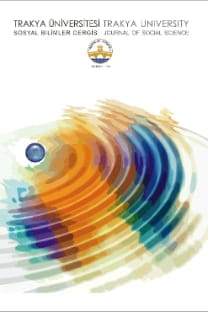BOUNDARIES, EDUCATION AND LICENCE: THE NINETEENTH CENTURY OTTOMAN STANDARDIZATION OF MEDICAL PROFESSIONS
Bu makale, geç Osmanlı İmparatorluğu döneminde modern ve merkezi tıbbı meslekten olmayan sağlık çalışanları ile yeni ortaya çıkan modern tıbbın uygulayıcılarının arasında tesis edilen sınırlar açısından değerlendirmektedir. Bahsedilen sınırlar yasal çerçeve ve yeni bir eğitim sistemi getirilerek üretilmiştir. Bu makale, Başbakanlık Osmanlı Arşivleri'nde belgelerin incelenmesi ile sınırların tanımlanma sürecine ilişkin çalışmayı derinleştirmektedir. Bu sınırlar, gelenekselin modernle arasındaki farkı ayırmada ve medikal aktörlerden oluşan farklı bir grup oluşturulmada etkili midir? Bu sorunun cevabı, tıp alanındaki çok sayıda aktör için rekabet ortamının tanımlanmasıyla aranmaktadır. Makale, sürecin temel sorunlarının yetersiz hekim sayısı ve merkeze olan mesafelerden kaynaklandığını ve bu sorunların 1890'larda yerleşmiş bir Müslüman Türk meslek örgütünün kurulmasına kadar ortadan kalkmadığını iddia etmektedir
SINIRLAR, EĞİTİM VE LİSANS: ON DOKUZUNCU YÜZYIL OSMANLI İMPARATORLUĞU’NDA SAĞLIK MESLEKLERİNİN STANDARTLAŞTIRILMASI
This article evaluates the establishment of a modern and centralized medicine in terms of creating boundaries between lay practitioners and the new medical staff in the Late Ottoman Empire. These boundaries were produced by the introduction of a legal framework and a new education system. This article intensifies the study on the process of definition of boundaries by a study of documents in the Prime Ministry Ottoman Archives. Have these boundaries been effectual in differentiating the traditional from the modern and setting a distinct group of medical actors? The answer to this question is sought by the description of a competitive environment for a multiplicity of actors of the domain of medicine. The article argues that the main problems of the process arose from the insufficient number of physicians and remoteness to the center and did not vanish until the foundation of a settled Muslim Turkish professional body in the 1890s
___
- Aksoy, Ö. A. (1988). Atasözleri ve Deyimler Sözlüğü I. İstanbul: İnkılap Kitabevi.
- Bassnett, S. ve Lefevere, A. (Eds). (1990). Translation, History and Culture. London: Pinter Publishers.
- Baker, M. (1992/2006). In other Words: A Coursebook on Translation. Routledge: London.
- Even-Zohar ,I. (1990). “Polysystem Theory”. Poetics Today 11(1): 9–26. Hermans, T. (Ed.). (1985). The Manipulation of Literature: Studies in Literary Translation. Beckenham: Croom Helm.
- Hermans, T. (1996). “The Translator’s Voice in Translated Narrative”. Target 8:1, 1996: 23-48.
- Karadağ, A. B. (2013). “Tanzimat Dönemi'nden İkinci Meşrutiyet Dönemi'ne Kadın Çevirmenlerin Çeviri Tarihimizdeki "Dişil" İzleri”. Humanitas (2), 105-126.
- Kemal, O. (1954/2016). 72. Koğuş. İstanbul: Everest Yayınları. Kemal, O. (2012). The Prisioners. (Çev. Cengiz Lugal). İstanbul:Everest Yayınları.
- Lefevere, A. (1992). Translation, Rewriting and the Manipulation of Literary Fame. London: Routledge.
- Newmark, P. (1991). About Translation. Great Britain: Cromwell Press Ltd. O’Sullivan, E. (2003). “Narratology meets Translation Studies, or, The Voice of the Translator in Children’s Literature”. Meta: journal des traducteurs / Meta: Translators' Journal. vol. 48, n°1-2: 197-207.
- Sağlam, M. Y. (2014). “Dünya Edebiyatına Uzanan Yolda Bir Türk Romancı: Orhan Kemal”. Erden Dergisi. 67, 87-103.
- Toury, G. (1980). In Search of a Theory of Translation. Tel Aviv University: The Porter Institute for Poetics and Semiotics. Venuti, L. (1995). The Translator’s Invisibility: A History of Translation. London and New York: Routledge.
- Yıldırım, C. ve Turan, D. (2016). “Orhan Kemal’in Romanlarının Fransızca, Almanca ve İngilizce Çevirileriyle Türk Kültürünün Yurt Dışında Temsili”, Turkish Studies (Prof. Dr. Hayati Akyol Armağanı), 11/4, 1091-1110.
- http://www.tedaproject.gov.tr/Eklenti/6515,42pdf.pdf?0 Erişim Tarihi: 28 Ekim 2016.
- http://www.tdk.gov.tr/index.php?option=com_bts&view=bts&kategori1=ver itbn&kelimesec=106326 Erişim Tarihi: 10 Kasım 2016.
- ISSN: 1305-7766
- Yayın Aralığı: Yılda 2 Sayı
- Başlangıç: 2000
- Yayıncı: Trakya Üniversitesi Sosyal Bilimler Enstitüsü
Sayıdaki Diğer Makaleler
DİSLEKSİ HAKKINDA GERÇEKLER: DİSLEKSİ NEDİR VE NE DEĞİLDİR?
MAĞDUR HAKLARI VE GEREKSİNİMLERİ BAĞLAMINDA ENGELLİ MAĞDUR BİREYLER
YEREL GAZETELERİN SİYASAL İLETİŞİMDEKİ ROLÜ-2002 GENEL SEÇİMLERİNDE EDİRNE YEREL GAZETELERİ
DEMOGRAFİK DEĞİŞKENLER AÇISINDAN NOSTALJİ EĞİLİMİNİ BELİRLEMEYE YÖNELİK BİR ARAŞTIRMA
GELENEKSEL JAPON KONAKLAMA BİNASI “RYOKAN”
ÖLÜDENİZ TABİAT PARKI HİZMET KALİTESİNİN ÖNEM PERFORMANS ANALİZİ İLE DEĞERLENDİRİLMESİ
